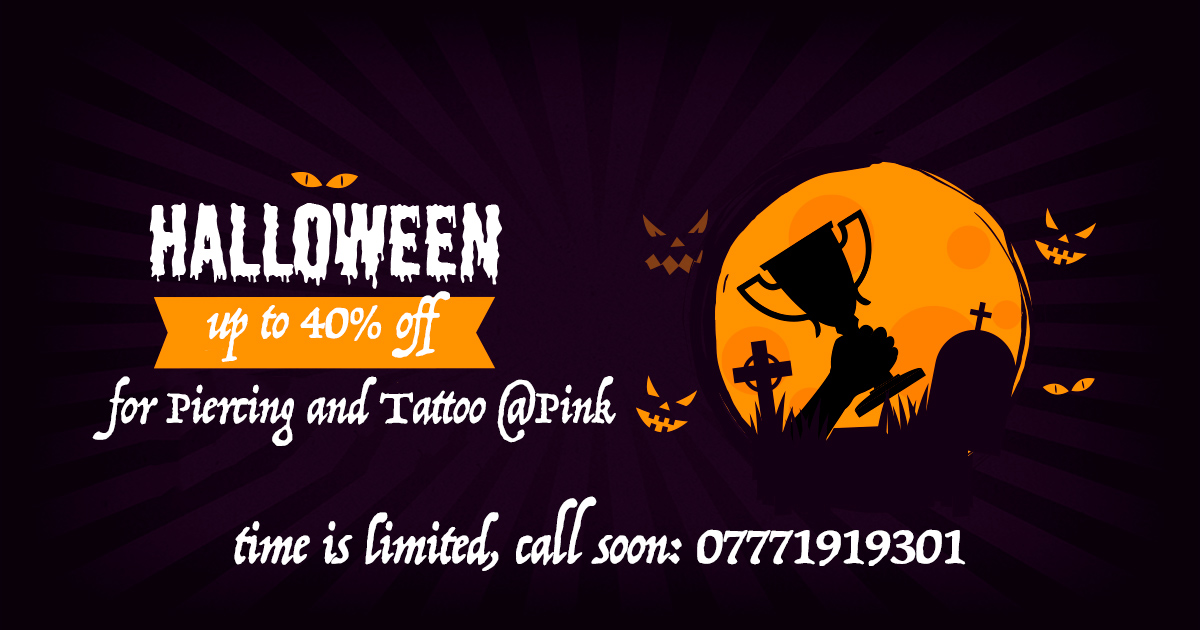The industrial piercing is a true architectural statement—a bold, edgy, and unmistakable feature of a curated ear. Also known as a scaffold piercing, it connects two separate points on the upper ear cartilage with a single, straight barbell, creating a striking visual line. At Pink Tatpier, London’s premier piercing studio, we specialise in the art and science of this complex piercing, ensuring perfect alignment, a safe healing journey, and a stunning final result.
However, the industrial is not a piercing to be undertaken lightly. It is one of the most anatomy-dependent and technically challenging piercings available. Success is entirely reliant on having the right ear shape and an expert piercer who can execute the procedure with absolute precision.
This guide is designed to give you a complete, honest overview. Get a professional anatomy assessment, a transparent cost breakdown, expert aftercare advice, and book your appointment with London’s industrial piercing specialists.
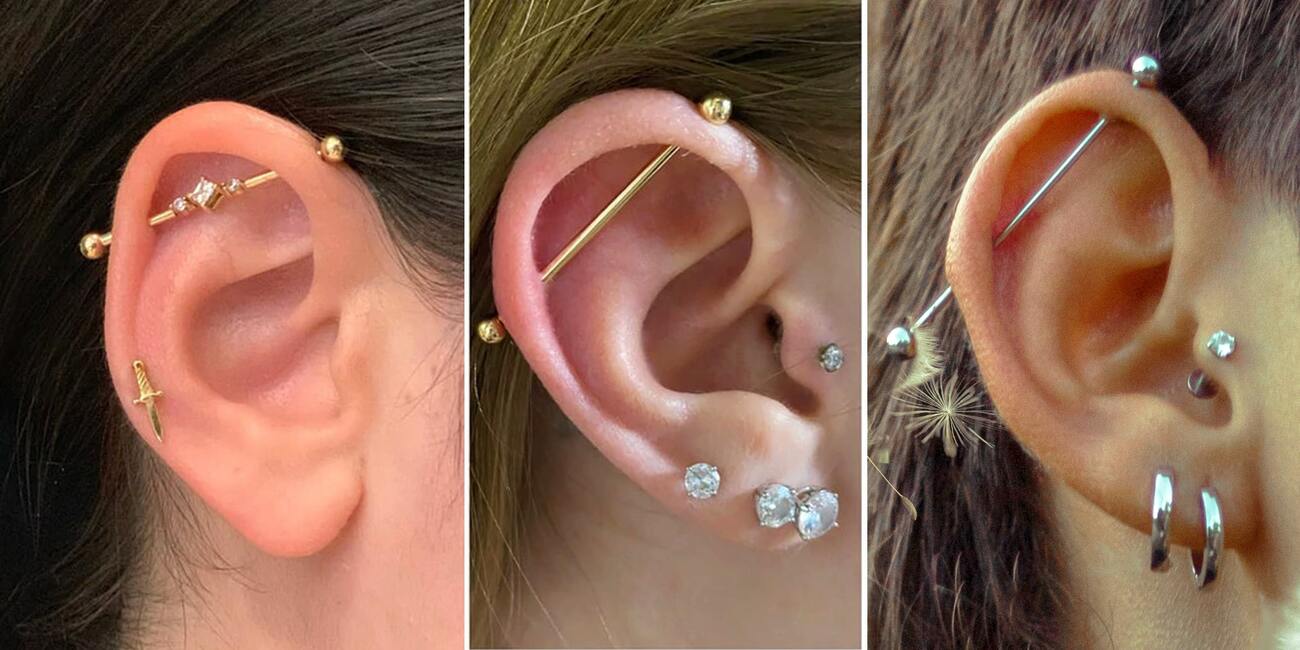
Industrial Piercing
The First, Most Critical Step: Is Your Anatomy Right for an Industrial Piercing?
Before you set your heart on an industrial piercing, we need to have an honest conversation about anatomy. This is, without question, the most important factor in the success of this piercing.
What is the Correct Anatomy?
A successful, traditional industrial piercing requires two specific anatomical features on the same ear:
- A well-defined outer helix ridge (the outer rim of your ear) that can safely support one end of the barbell.
- An equally prominent forward-helix ridge (the part of the rim closer to your face) to support the other end.
Crucially, the flat of your ear between these two points must be low enough that the barbell can pass cleanly over it without touching or pressing down on it.
The Risks of Piercing Unsuitable Anatomy
Forcing an industrial piercing on an ear that does not have this specific structure is the primary cause of all major complications. It is irresponsible and will lead to:
- Severe Pressure Sores: If the bar rests on the flat of your ear, it will create a painful pressure sore that will never heal and can lead to permanent scarring.
- Migration and Rejection: The constant, unnatural pressure will cause the body to slowly push the piercing out of the skin, resulting in significant scarring.
- Extreme Healing Bumps & Irritation: The piercing will be constantly angry, swollen, and prone to large, persistent irritation bumps.
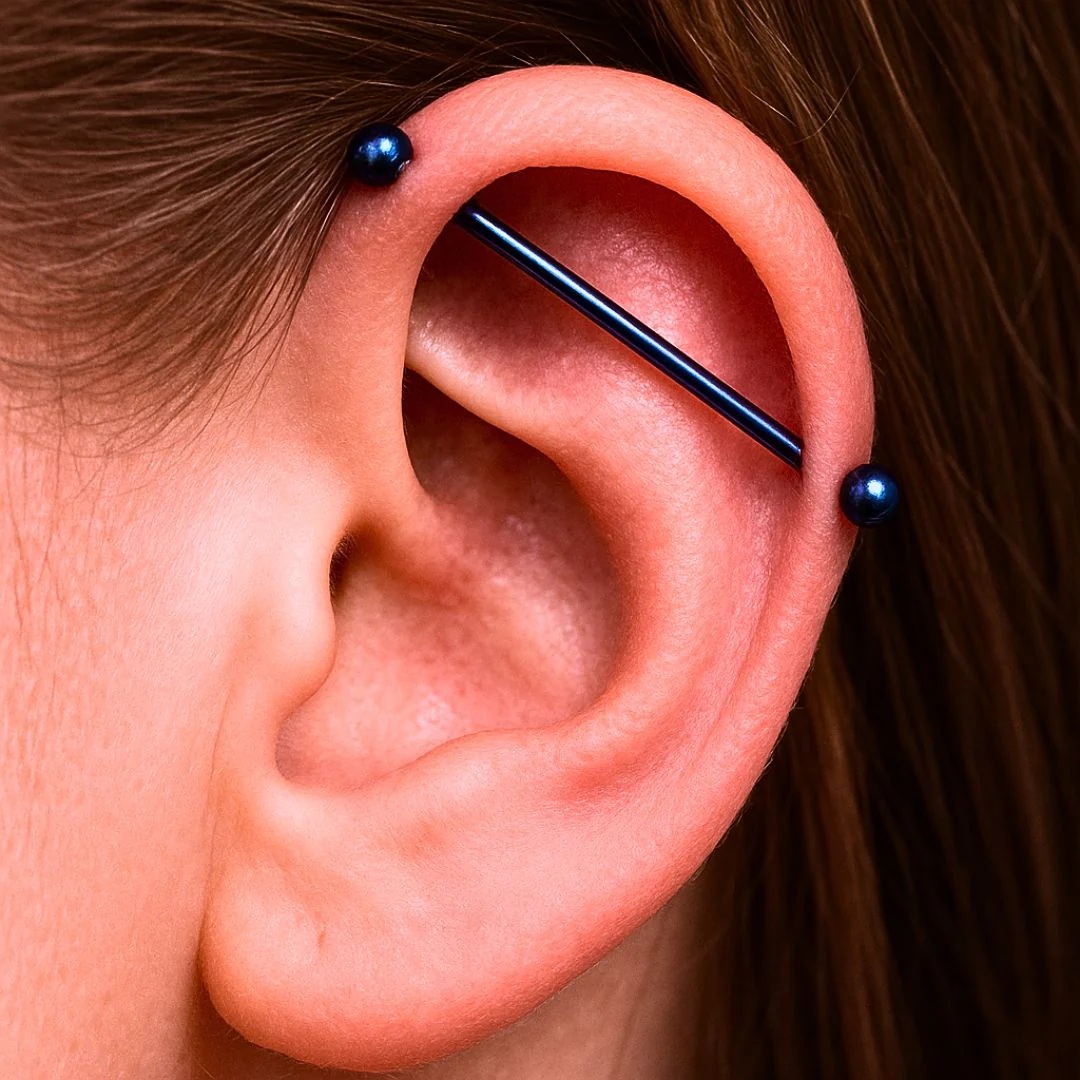
Industrial Piercing
Our Professional Assessment Promise
Your safety and the long-term health of your piercing are our absolute priorities. During your consultation at Pink Tatpier, our expert piercer will conduct a thorough, hands-on assessment of your ear’s structure. If a traditional industrial piercing is not a safe or viable option for you, we will be honest and explain exactly why.
We would rather have a happy, well-informed client than perform a piercing we know is destined to fail. But this doesn’t mean your dream of this look is over. We can then explore creative alternatives.
Creative Alternatives: The Custom Industrial Project
If your anatomy isn’t suitable for a traditional straight barbell, we can often create a “custom industrial” project. This is an advanced technique that achieves a similar aesthetic while working with your unique ear shape. A custom industrial typically involves:
- Two separate, correctly angled helix piercings healed independently.
- Once healed, they are connected by a custom-bent barbell or a decorative chain that is measured and made to fit your ear perfectly.
This approach offers far more flexibility and is a safe, beautiful solution for those who cannot accommodate a standard industrial.
The Industrial Piercing Process: A Feat of Precision
If you are a suitable candidate, your piercing will be performed with meticulous care.
- Anatomy Confirmation: We double-check your ear’s structure to confirm viability.
- Jewellery Selection: You will select an appropriately sized, implant-grade titanium straight barbell.
- Meticulous Marking: This is a critical step. The piercer will carefully mark both piercing points to ensure they align perfectly, creating a straight, clean channel.
- The Piercing Procedure: Two separate piercings are made swiftly and hygienically with sterilised, single-use needles.
- Barbell Insertion & Aftercare: The initial barbell is carefully inserted, and we provide you with a comprehensive aftercare plan.
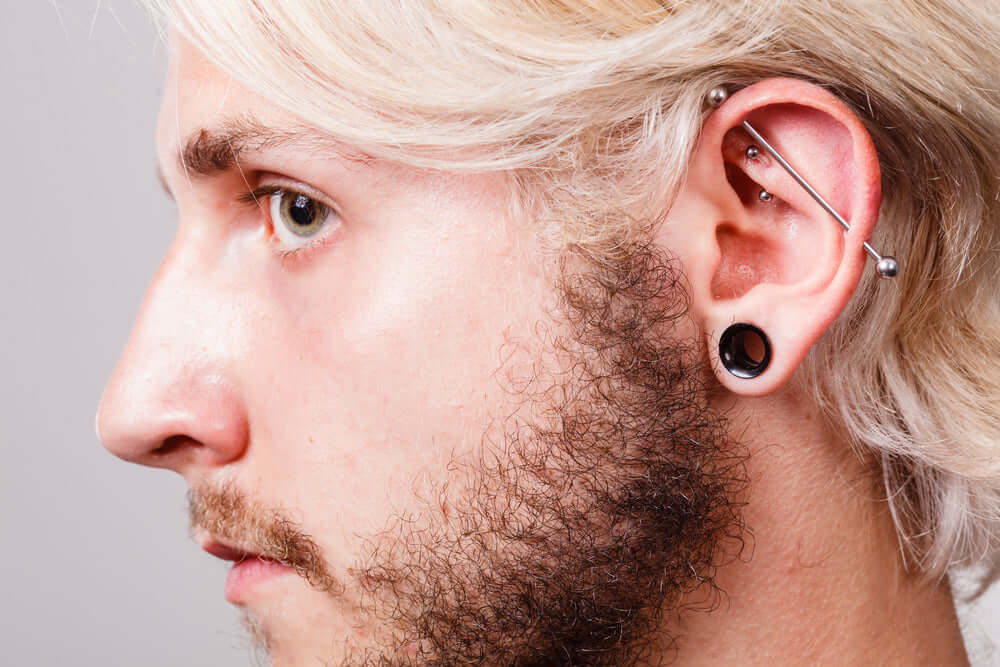
Industrial Piercing
Industrial Piercing Cost, Pain & Healing: Your London Guide (September 2025)
Pain Level: An Honest Assessment
The industrial piercing involves two separate cartilage piercings in one sitting. As such, it is considered to be on the higher end of the pain scale. Most clients rate the pain at a 7-8 out of 10. You will feel two distinct, sharp pinches. The ear will feel very sore, swollen, and tender for several weeks afterwards.
Healing Time: The Ultimate Test of Patience
The industrial is notoriously slow and difficult to heal. Because it is essentially two piercings trying to heal while being connected by a single piece of jewellery, it is prone to irritation. Expect a full healing time of 9 to 12 months, and often up to 18 months. Diligent, consistent aftercare is non-negotiable.
Cost of an Industrial Piercing in London
The price reflects the advanced skill level and the fact that it is two piercings in one. Your total cost is the service fee plus the cost of your chosen jewellery.
| Service | Price (GBP) | What’s Included |
| Industrial Piercing Service Fee | £60 – £75 | Specialist consultation, in-depth anatomy assessment, two aligned piercings, sterile procedure, and a comprehensive aftercare guide. |
| Initial Jewellery | Starts from £30 | An implant-grade titanium straight barbell. Price varies for custom lengths, anodisation, or decorative ends. |
| Total Starting Price | From £90 – £105 | The service fee + the cost of your chosen jewellery. |
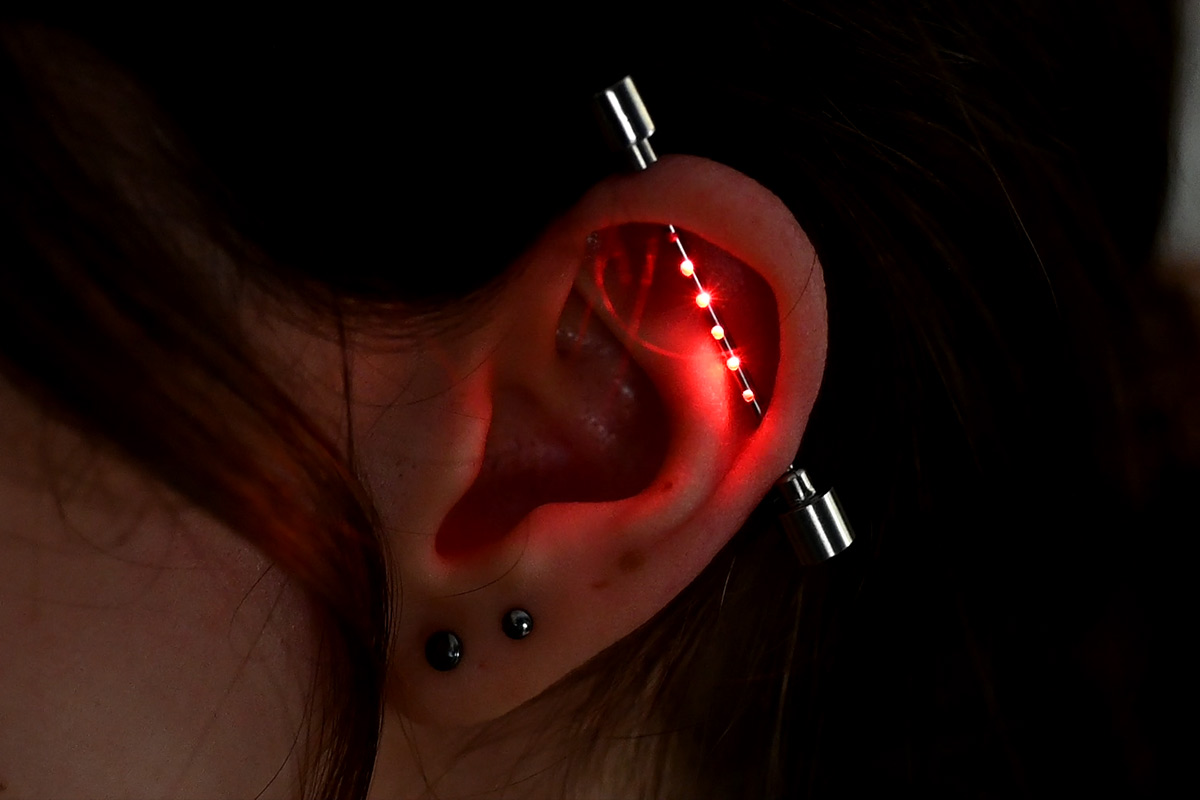
Industrial Piercing
Jewellery for Your Industrial Piercing
For the entire initial healing period, the only appropriate jewellery is a simple, high-quality straight barbell made from implant-grade material.
- Material: We exclusively use Implant-Grade Titanium (ASTM F-136) or 14k/18k Solid Gold.
- No Frills: The initial bar should not have any dangling charms or complex shapes, as these can snag and cause severe irritation.
For a Healed Piercing
Once your industrial is fully healed (after a year or more), you can explore the exciting world of decorative industrial barbells. This includes bars with intricate centrepieces, arrow designs, chains, and custom-anodised colours. We can help you get measured for a perfectly fitting decorative piece.
Professional Aftercare Tips for a Successful Industrial
A successful industrial piercing is 50% a great piercer and 50% perfect aftercare. You must be diligent.
- DO clean the entry and exit points twice daily with a sterile saline solution.
- DO NOT sleep on the piercing. This is the number one cause of failure. Use a travel pillow and place your ear in the hole to avoid any pressure. This is non-negotiable.
- BE VERY CAREFUL WITH YOUR HAIR. Long hair is the arch-enemy of a healing industrial. Keep your hair tied back and be extremely cautious when brushing it to avoid snagging the bar.
- AVOID PRESSURE from glasses, headsets, hats, and helmets.
- DO NOT twist, turn, or play with the barbell.
- DO come back for regular check-ups. We are happy to check on the healing progress and address any concerns, such as the formation of irritation bumps.

Industrial Piercing
Frequently Asked Questions About Industrial Piercings
1. Why can’t I just heal it with two separate studs and connect them later?
The angle required for a straight barbell to pass through the ear is different from the angle of two individual helix piercings. If you heal them separately with studs, they will almost never align correctly to wear a single, straight bar later on without putting immense pressure on the channels. A “custom industrial” project is the correct way to approach this if a single bar isn’t viable from the start.
2. What are the bumps on my industrial piercing?
These are almost always irritation bumps (hypertrophic scarring), not infections. They are very common with industrial piercings and are caused by pressure, snagging, or sleeping on the piercing. They can be treated, but the source of the irritation must be eliminated first.
3. Can I get a vertical industrial piercing?
A vertical industrial connects two points on the helix rim vertically. It is also highly anatomy-dependent but is a possible option for some. This would need to be assessed during a consultation.
4. What if my ear isn’t the right shape?
As mentioned, we will honestly advise against a traditional industrial. We would then be delighted to discuss a custom project using a chain or a bent bar that will give you a similar look while honouring your unique anatomy.
Ready for London’s Most Iconic Cartilage Piercing?
The industrial piercing is a commitment, but when done right, it’s one of the most rewarding and visually impressive piercings you can get. The key to success is a professional, honest assessment from a specialist who puts your safety first.
If you are considering this bold piercing, we invite you to our London studio. Let our experts assess your anatomy, discuss your options, and help you begin your journey safely.

